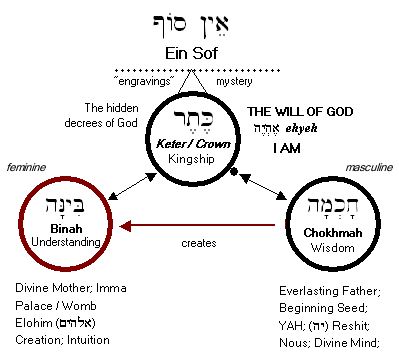In the works of Kabbalah such as the Zohar, creation is described as a process of emanation from the inner divine mystery outward to the cosmos, and diagrammed as a ‘journey’ from the highest to the lowest of the ten sefirot which make up the Tree of Life. Metaphors of duality and polarity abound in this account, which on a personal level also represents the primal ‘stages of inner mental activity.’

This journey from inner divine Nothingness toward the beginning of existence is one that inevitably arouses duality, even within the inner realms. As Hokhmah emerges, it brings forth its own mate, called Binah, or “contemplation.” Hokhmah is described as a point of light that seeks out a grand mirrored palace of reflection. The light seen back and forth in these countless mirrored surfaces is all one light, but infinitely transformed and magnified in the reflective process. Hokhmah and Binah are two sefirot that are inseparably linked to one another; each is inconceivable to us without the other. Hokhmah is too fine and subtle to be detected without its reflections or reverberations in Binah. The mirrored halls of Binah would be dark and unknowable without the light of Hokhmah. For this reason they are often treated by Kabbalists as the primal pair, the ancestral Abba and Imma, Father and Mother, the deepest polarities of male and female within the divine (and human) self. The point and the palace are also primal Male and Female, each transformed and fulfilled in their union with one another. The energy that radiates from the point of Hokhmah is described chiefly in metaphors of flowing light and water, verbal pictures used by the mystics to speak of these most abstract levels of the inner Mind. But images of sexual union are never far behind these; the flow of light is also the flow of seed that fills the womb of Binah and gives birth to all the further rungs within the ten-in-one divine structure, the seven “lower” sefirot.
The terms Hokhmah and Binah reflect two qualities or stages of inner mental activity, and indeed they may be experienced within the self as two aspects of mind: the first flash of intellect, the creative spark, and the depth of thought that then absorbs the spark, shaping and refining it as it takes it into itself. This is a rendition in terms of mental process of that same image of the “point” and the “palace,” showing that the language of Kabbalah may be read simultaneously as a myth of cosmic origins and a description of events within the mystic’s mind. Binah is thus described by the term quarry, the rocky place out of which the letters are hewn forth. Hokhmah, the flash of intellect, seeks articulation. Itself only the single point of a yod, it carves deeply into the mind in quest of “letters” or language through which its truth will be spoken. This primal forming of language, still silent within the mind, carries the self-revealing process of creation a step further in the emergence of cosmos, Torah, and the mystic’s own mind. That this should be the case is taken for granted by the Kabbalist, since his mind is a microcosm of that which exists “above” and has been created in such a way as to permit it it to both reflect and affect happenings on the cosmic plane.— Arthur Green (2004, 40-41)
‘The inner structure of psychic life is the hidden structure of the universe; it is because of this that humans can come to know God by the path of inward contemplation and true self-knowledge’ (Green 2004, 47).